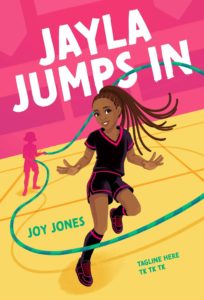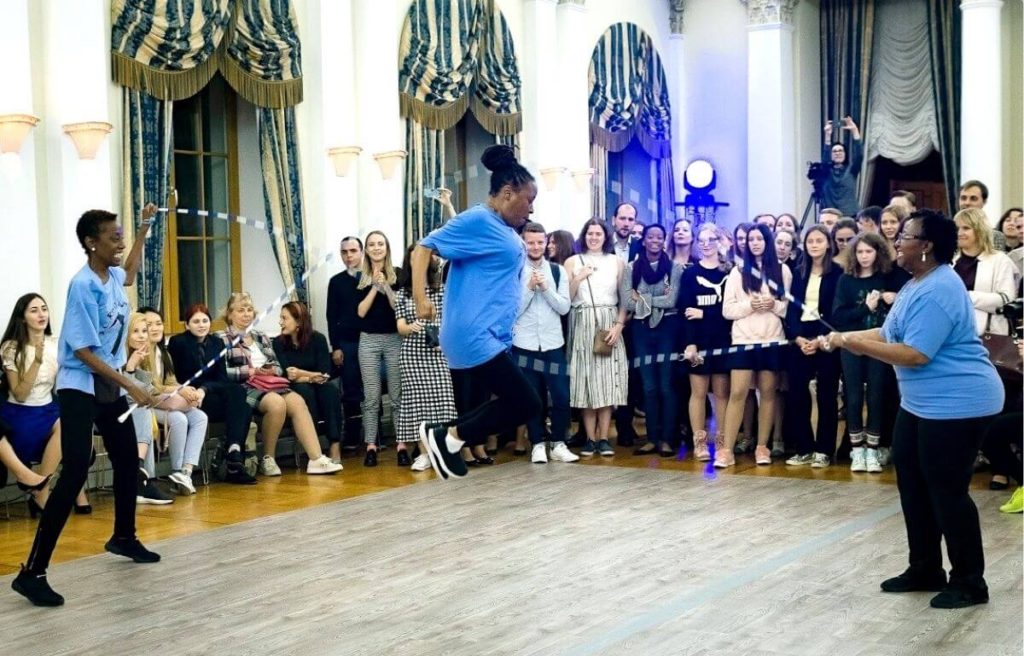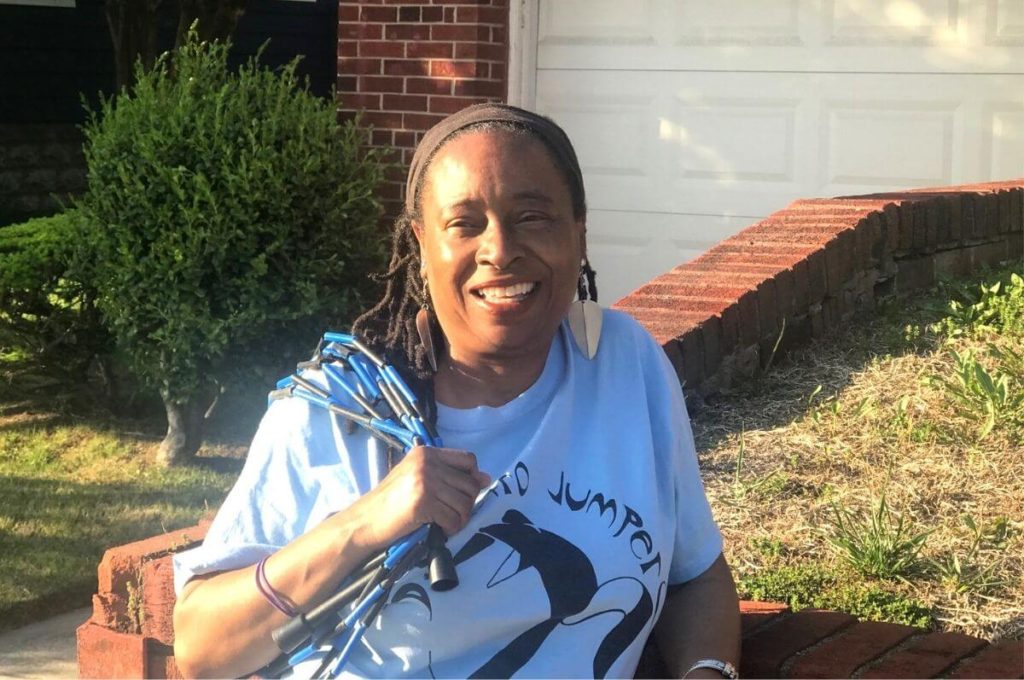This post was last updated on July 13th, 2022 at 09:46 am
Joy Jones is proof that becoming an adult doesn’t mean you must give up the games you loved playing as a child.
Far from it.
In fact, you can embrace these games all the more as an adult, like Jones did with Double Dutch. “Ironically, I’ve jumped Double Dutch more as an adult than I did as a kid,” she told Frugalmatic in an interview. “As a kid, I jumped single rope more frequently.”
How Jones rediscovered Double Dutch, a game featuring two people swinging a pair of ropes while a third person rhythmically jumps between them, is a story of life imitating art. Jones, who lives in Washington, D.C., first dabbled with the idea of returning to her jump-rope roots in the 1990s while working as a public school administrator.
One day Jones suggested she and her co-workers start jumping rope over their lunch break. “Then everybody said, ‘Oh, I’m too old.’ Or, ‘My back is bad.’ Or, ‘My knees are weak.’ Or, ‘We’re grown women. We can’t do that,’” Jones explained. “So we never did it, but I thought it was a cute idea.”
The experience led Jones to write a play, “Outdoor Recess,” about a group of women who jump rope on their lunch hour. To promote the play, Jones decided to put on Double Dutch exhibitions, and that’s how DC Retro Jumpers formed in 2004.
The first members were all women over 50. Today, participants are all ages, and they’ve gone beyond performing at neighborhood events. In 2018, Jones and other members traveled to Moscow as cultural ambassadors, introducing Russians to Double Dutch.
After years of promoting the game, Jones thought she had said everything that needed to be said about it, but she wasn’t done yet. Her literary agent encouraged Jones to write a young adult book about Double Dutch.

“She was sort of persistent, and she knows the market,” Jones said about her agent. “So I said, ‘Let me see if I can come up with a story.’”
The result was “Jayla Jumps In,” which captures Jones’ own attitude toward fitness. In the book, 11-year-old Jayla learns about Double Dutch through a YouTube video. When Jayla discovers her mom played Double Dutch as a child, she begs her mom to show her how to do it.
Jayla’s mom is initially reluctant, but then a hypertension diagnosis motivates her to make a lifestyle change. Ultimately, the game offers Jayla’s mom a path to becoming physically fit. It also becomes a bonding experience among family and friends.
Jones sees Double Dutch as a way to enjoy exercise. Her mantra is, “Not everyone likes to exercise, but everyone likes to play.”
Read more excerpts from the interview with Joy Jones below. Learn more about her at JoyJonesOnline.com.
Frugalmatic: Whether it’s Double Dutch, rollerblading, basketball, or another physical activity, why do you think it is that so many adults stop playing games that they enjoyed as kids?
Joy Jones: That’s a good question. Sometimes when we’re doing Double Dutch, a woman will say, “Why would I ever stop?” Because she’s having so much fun. And all those feelings of exhilaration kick in when your endorphins are stimulated. And she’s like, “Why don’t I have this joy in my life any longer?”
And I think a lot of times adults think playing is only for children. But everybody needs to play. Everybody needs time to recreate and nurture that part of the soul that needs to relax and rejuvenate.
So I think we feel other things are more important, and so we give priority to some of the mundane tasks of being a grown-up that don’t include that need for physical exercise and release.
Enjoying this post? Read more Frugalmatic interviews
F: You’ve talked about how DC Retro Jumpers has been an important part of reaching out to others about Double Dutch. I imagine some of your adult peers are quick to embrace Double Dutch, while others might need a little persuading. What is it about Double Dutch that makes it appealing?
JJ: When we’re out at a festival, there’s always a lot of people waiting for their turn to jump rope. And there’s always one person on the edge of the crowd standing on the fringe apprehensive. I can recognize the look. They really, really want to do it, but they’re scared. Scared that they’ll look foolish or won’t be able to do it.
They inch closer and closer, and then they get in line. We give them some very basic instructions because all you’re doing is going up and down. They get in the rope, and they’re over the moon with joy because they’re actually doing it. Something they didn’t think was going to happen just happened.
The wonderful thing about when we do Double Dutch is that there’s always a pool of onlookers. Especially if they see you’re a little apprehensive, there’s loads of applause for you, cheers, and high-fives. How often in your regular life do you get praised for doing a good job, do you even get a pat on the back? Not too often, even if you’re doing all the right things. But in Double Dutch, your reinforcement is immediate.

F: With the young adult novel you wrote about Double Dutch, “Jayla Jumps In,” what has been the response from young readers? Is Double Dutch something they’re familiar with or has your book opened a new world for them?
JJ: Regrettably, Double Dutch is not that familiar from first-hand observation or experience for most young people. I’m sorry to say that, at least where I am, children don’t play outside a whole lot. When they read about Double Dutch, their curiosity is sparked. And then when we’re in a place where children can experience Double Dutch, they’re excited.
During the (pandemic) lockdown, several parents called my (DC Retro Jumpers) colleague, Robin, and said, “Please come to our house. Please come to our neighborhood and bring those ropes because this kid is driving me crazy.” Or, “My kid is begging for Double Dutch.” Because school was closed. That meant even the rudimentary opportunity to have some organized play outside or recess period was gone. And a lot of parents didn’t think to include that.
We were able to offer to some students a facsimile of outdoor recess, as a result of some flustered parents saying, “Help!”
F: How do we as a culture encourage today’s youth to become more physically active? So many of them turn to smartphones and video games for entertainment.
JJ: It’s important to give children the opportunity to experience things outside of the television, outside of the computer screen, beyond their cell phone. So I give kudos to the parents who called to say, “Bring your rope so I can give my kid a chance to jump rope for 15 minutes because he has all this energy that needs to go somewhere.” And kudos to the kids who do social media but know how to put the phone down and do something else, to engage in a game that requires them to interact with other people. Or, to make something and not just consume something.

